A Pathetone Weekly news featurette from the 1930s, in which our intrepid news hound guessed what the average woman about town would wear in 2000. The light-bulb head-dress is a winner.
A Pathetone Weekly news featurette from the 1930s, in which our intrepid news hound guessed what the average woman about town would wear in 2000. The light-bulb head-dress is a winner.

It’s a Boy’s Own Adventure Story moment. You’re at a concert with your best pal, watching your favorite band, when the drummer collapses on stage. The call goes out, “Is there a drummer in the house?” Next thing you know, your buddy has pushed you into the spotlight and there you are playing the drums with your heroes.
Well this is kind of how it went for Scot Halpin when he turned up to see his favorite band The Who open their Quadrophenia tour at the 14,000 seater Cow Palace in Daly City, San Francisco, in November 1973. Halpin and his companion arrived 12 hours before the concert began to ensure they would have good seats. They found seats up near the front of the stage, which was fortuitous for both Halpin and the band, as an hour into the gig, drummer Keith Moon passed out and was carted off stage.
The house lights came up, and a thirty minute intermission followed, while Moon was revived backstage with “a cold shower”. The Who returned to the stage, and started performing, but once again Moon collapsed - this time for good. It later transpired that Moon the Loon had ingested massive quantities of animal tranquilizers, which he had washed down with his usual bottle or two of brandy. His three band mates, Roger Daltrey, Pete Townshend and John Entwistle carried on, performing their next number “See Me, Feel Me”, with Daltrey filling-in for Keith’s drums on tambourine, before Townshend asked the audience:
“Can anybody play the drums? I mean someone good!”
It was at this moment Halpin’s companion started yelling at the stage crew that his friend could play. What he omitted to say, was that Halpin was slightly out of practice, as it was nearly a year since he had played. What happened next surprised both band and audience, and has become the stuff of legend, when concert promoter, Bill Graham approached Halpin and pulled him up onto the stage.
“Graham just looked at me and said, ‘Can you do it?’ And I said ‘Yes,“‘straight out. Townshend and Daltrey look around and they’re as surprised as I am, because Graham put me up there.”
A roadie then gave Halpin a shot of Moon’s brandy.
“Then I got really focused, and Townshend said to me, ‘I’m going to lead you. I’m going to cue you.’”
Townshend introduced him as “Scot”, and went straight into a couple of Blues standards, “Smoke Stack Lightning” and “Spoonful”. Halpin acquitted himself, kept good time and followed Townhend’s lead. Next up was The Who’s “Naked Eye”, which proved far more tricksy with its contrasting tempos. However, Halpin kept his cool and managed a steady beat throughout.
It was the band’s last number and Halpin deservedly then took his bow alongside Townshend, Daltrey and Entwistle. Backstage the band thanked:
...the skinny kid from the audience for stepping to the plate but didn’t hang around long after the show.
“They were very angry with Keith and sort of fighting among themselves,” Halpin said. “It was the opening date on their ‘Quadrophenia’ tour, and they were saying, ‘Why couldn’t he wait until after the show (if he wanted to get high)?”
Daltry, who’d begun drinking Jack Daniels from the bottle at that point, told the substitute they’d pay him $1,000 for his efforts, and a roadie gave him a tour jacket on the spot. “Then everyone split,” Halpin said. “My friend and I both had long drives ahead of us, so we loaded up on all the free food that was put out for the band, and we both headed for home.”
In the meantime, someone stole the tour jacket that Halpin had just received as a gift.
Halpin received favorable mention in the next day’s Chronicle review. He received a nice letter from the band but no money - not that it mattered.
However, the event was commemorated by Rolling Stone magazine, when they honored Halpin with “Pick-Up Player of the Year 1973.” Interviewed at the time, Halpin praised The Who’s stamina, saying:
“I only played three numbers and I was dead.”
Halpin went onto graduate from San Francisco University, and became composer-in-residence at the Headlands Centre for the Arts, in Sausalito, California. He also played with a number of bands including The Sponges, Funhouse, Folklore, Snake Doctor and Plank Road and also managed a punk rock nightclub before moving to Bloomington, Indiana, in 1995 to become a visual artist.
Halpin died in February 2008, less than a week after his birthday, he was 54.
More of Scot Halpin and The Who, plus bonus clip, after the jump…
With thanks to Heather Harris for suggesting this story!

David Bowie sings “Drive-in Saturday” and is interviewed by British TV host, Russell Harty, from 1973.
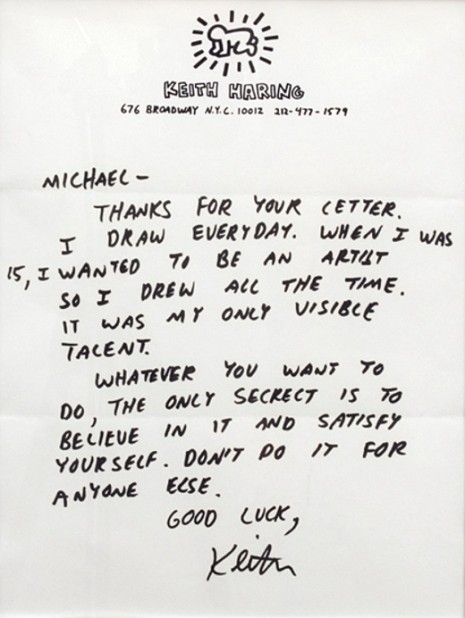
An “ultra-rare hand-written” letter by artist Keith Haring came up for auction last year on gottahaverockandroll.com.
Written in 1987, the letter was addressed to a young artist seeking guidance on their chosen career. Haring gave the youngster sound advice:
Whatever you do, the only secret is to believe in it and satisfy yourself. Don’t do it for anyone else.
Via Letters of Note
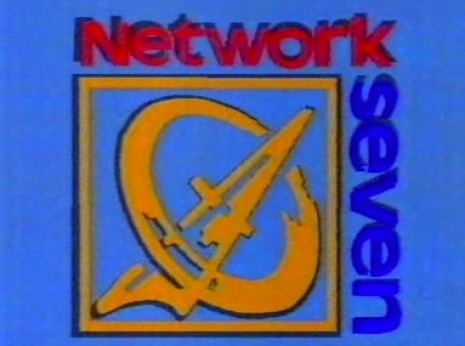
Network 7 was a love it or loathe it British TV series from the 1980s that changed television for good. Launched in 1987, it ran for two series, until 1988, and was aired on Sundays between 12 and 2pm, on Channel 4. There had been nothing like it, but there have been plenty of copies since.
Devised by Janet Street-Porter and Jane Hewland, Network 7 gave a voice to British teenagers and twenty-somethings, sowed the seed of Reality TV, and put “yoof culture” at the heart of the TV schedules.
Strange to think now, but back then youth TV was limited to roughly three shows: the educational Blue Peter, which was a cross between homework, the Boy Scouts and the Girl Guides; Top of the Pops, the legendary chart run-down show, hosted by Jimmy Saville and “Hairy Monster” Dave Lee Travis; and The Tube an anarchic live music series from Newcastle. And that was that.
Set in a ramshackle warehouse in London’s Limehouse, Network 7 changed all this by taking its audience seriously and offering feature items, news stories, music and interviews on issues that were topical, relevant and often ground-breaking: from exposes on bank card fraud, to Third World debt, AIDs, bulimia, bullying and gangs. Network 7 was also radical in that it was presented by “yoof”, and made stars of Sebastian Scott, Magenta Devine, Sankha Guha, Jaswinder Bancil and Trevor Ward.
It was easy to see why Ward was the best of the bunch, for he didn’t try and be a traditional presenter, something all the others did (and often badly). No, he was himself, and tackled each story with his own clever and original take. Trevor Ward was the main reason for watching Network 7, it was like having a young Hunter S. Thompson presenting a TV show - for Ward brought a steely journalistic edge to what was basically a day-time series presented by young things.
I contacted Trevor to find out how he got started:
I was working for Mercury Press agency in Liverpool in 1987 under the brilliant and inspirational Roger Blyth when I was 26. Network 7 was a brand new Sunday morning show, like a thinking-man’s Tiswas. About halfway through their first series, they said they were looking for a reporter. The following week, they repeated their appeal, but this time they said the applicants had to be Northern. So I sent in my CV and was invited down to an interview on the set – a load of reconditioned caravans in the middle of a big warehouse in East London. Janet Street Porter and Jane Hewland gave me a merciless grilling and I drove home convinced I hadn’t got the job.
The next day, a researcher rang me and said I was on the final short list of three, and that we would be expected to come down to London the next Sunday to do a live audition on that day’s show. The viewers would vote in a live telephone poll for who got the job.
I thought it was a brilliant idea, even though there was a one in three chance it could end in nationally-televised humiliation for me.
That week’s show was coming live from a Rock against Racism festival in Finsbury Park, and we each had to find a story during the programme’s two-hour running time to present to camera in under a couple of minutes about half an hour before the end.
I thought it was pretty obvious that it would have to be a PTC rather than an interview if we were to successfully sell ourselves to the viewers in such a short timespan, so I harvested a load of juicy anecdotes from a bunch of bouncers and turned those into a script which ended with about six of them carrying me off camera. I was unaware of what the other two were upto, and later found out they’d chosen to interview people from worthy causes represented at the festival.
Anyway, I got almost half the votes, so was declared the winner at the end of the show.
You can gather from this why Ward was the show’s highlight - he approached stories in an interesting and intelligent way. Every fuckwit would have gone all hang-wringing and worthy, but not clever Trevor, and that’s why he is so good.
My first live story on Network 7 was on its Death Penalty programme. Network 7 was brilliant for pioneering viewer interaction, and viewers were regularly asked to vote on a range of issues. That week it was the death penalty and whether a particular Death Row inmate –whom we had a live satellite link with – should die. I was handed the London, studio-end of things. It was incredibly nerve-racking. My first piece -to-camera (PTC)– at the top of the two-hour programme – was a two—and-a-half-minute walking/talking shot – an eternity in TV time - referring to various modes of capital punishment – all without autocue.
That was the other thing about Network 7 it engaged with its audience, it was like a social network for news stories, features and information. And by god did they pump that screen full of information - from what was coming up, to the temperature in the studio. Even so, for a generation it was compulsive viewing, and opened the gates to more accessible, more informative, more entertaining TV.
Janet Street-Porter went onto to win a BAFTA for Network 7 and was then appointed head of “yoof” TV at the BBC, before, more recently, returning to journalism. Trevor Ward continued as a journalist (writing for Loaded, The Guardian, and working as an editor on the Daily Record) and presenter, and is now a highly respected writer, producer and documentary-maker.
There aren’t many clips of Network 7 out there, and sadly none with Ward, but the few that are do give a hint of what the show was like. This selection ranges from opening titles, an item on gay youth and “coming out” (which was highly controversial subject back then), Madonna in concert, and an interview with The Beastie Boys.
More clips of ‘Network 7’, plus bonus French & Saunders spoof and Trevor Ward documentary, after the jump…
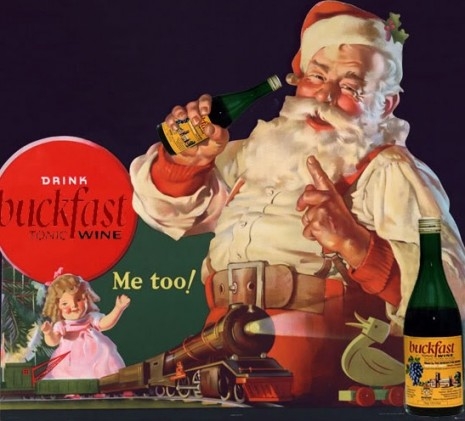
The author Evelyn Waugh once described New Year’s Eve as ‘‘drunk men being sick on a pavement in Glasgow,” which is probably true, for part of the great Scottish tradition of Hogmanay is to get drunk, though being sick is non-obligatory. Amongst the fine selection of alcohol chosen by Scots to celebrate the arrival of 2011 (especially for Glaswegians, or Weedgees), is a tipple made by Benedictine monks at Buckfast Abbey in Devon.
Buckfast is a fortified wine first produced by the monks in 1890 from a French recipe. It was first sold in small quantities as a medicinal tonic under the advertising slogan:
“Three small glasses a day, for good health and lively blood.”
In 1927, the monks lost their license to sell this medicinal plonk, so the Abbot negotiated a deal with a wine merchant to distribute their booze the length and breadth of the United Kingdom. Its recipe was changed to make it more palatable, and Buckfast, or Buckie as it is known colloquially, became the drink of choice amongst the working class, low-rent bohemians, NEDs (non-educated delinquents) and soccer fans.
Buckie is cheap, potent and effective for inebriation. It is also sweet-tasting and is highly caffeinated - one bottle contains the equivalent to eight cups of instant coffee. Recently, various politicians have called for a ban on Buckfast in Scotland, as it was claimed the “Commotion Lotion” has been responsible for anti-social behavior, as the New York Times reported:
..a survey last year of 172 prisoners at a young offenders’ institution, 43 percent of the 117 people who drank alcohol before committing their crimes said they had drunk Buckfast. In a study of litter in a typical housing project, 35 percent of the items identified were Buckfast bottles.
A BBC TV investigation into Police figures revealed:
...the drink was mentioned in 5,638 crime reports in Strathclyde from 2006-2009, equating to three a day on average.
One in 10 of those offences were violent and the bottle was used as a weapon 114 times in that period.
Against this goes the argument from the wine merchants, who say Buckfast is but one of many alcoholic drinks available, of which Buckie represents only 0.58% of total alcohol sales - which is, to be fair, but a piss in the Ocean.
Back in the early 1990s, writer and broadcaster Stuart Cosgrove produced an excellent arts magazine series for Channel 4, called Halfway to Paradise. It was launching pad for many talents including Hollywood director, Jim Gillespie and producer, Nicola Black. In this short clip, Cosgrove examines the history of the famed drink and its culture. Since then, and with the advent of YouTube and camera ‘phones, fans of Buckfast have developed a new trend - the Buckfast Challenge, where devotees to the “Coatbridge Table Wine” down a bottle in seconds. The record, for those interested, is seven seconds. Happy Hogmanay.
Buckfast drunk in seven seconds, after the jump…
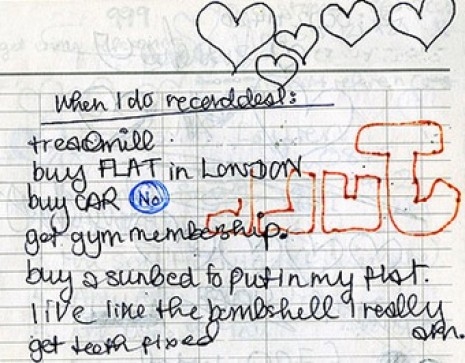
A selection of Amy Winehouse’s teenage lyrics and a “to-do-list” has been found in a “stash of dumped school books,” Britain’s Sun reports:
They also include diary entries the Rehab singer made when 17 in 2001, the year before she landed a recording contract.
In one Amy, who has fought cocaine and booze addiction, urges herself to “live like the bombshell I really am”.
In another she tells of her lust for a fella named Felix and writes: “There’s too much sexual tension.”
Amy, now 27, scrawled lyrics amid course work for an English Literature A-level. She wrote “Amy’s Songs” on the front of a red notebook.
Lines include: “I’m digging myself into a hole/These days I’ll just work when once I had so much soul.”
Another verse starts: “Drain my drink & order more.” And a third - “Find someone with whom I can come undone” - predicted her future with junkie BLAKE FIELDER-CIVIL.
The books were found in rubbish on a North London street.
Amy’s to-do-list includes: buy a flat, buy a car, buy a sunbed, get a gym membership - all of which pales into insignificance when compared to what Amy eventually did do.
Full pics and story here.
Amy’s youthful longing.

The shape of things to come?

Via The Sun
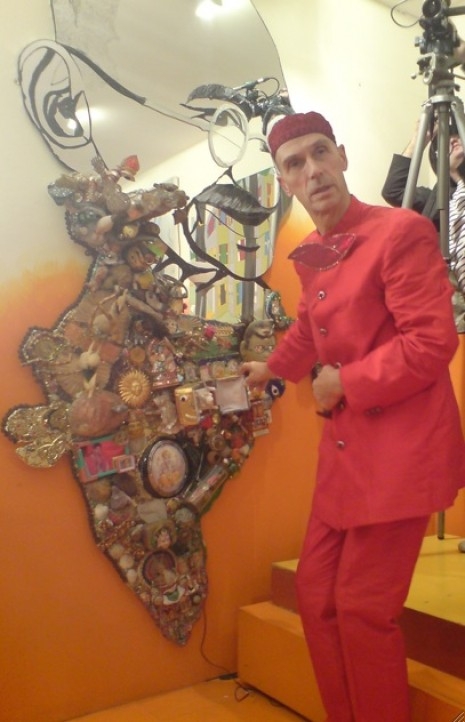
I once met the artist, sculptor and jewelry-maker, Andrew Logan at a Divine concert in Edinburgh, circa 1984. He was charming and delightful and showed me a selection of his jewelry designs, including a ring with a tiny book attached. He told me there was nothing written in it yet, and full of youthful enthusiasm, I offered to write him something. I did, but never sent it. A pity, for opportunity only ever comes once.
Andrew’s work mixes Pop Art with Neo-Romanticism, and a pinch of English eccentricity. He is the only living artist with a museum in Europe, of which music maestro Brian Eno said:
‘Andrew’s work doesn’t offer that much to the would-be catalogue mystifier: if you start saying anything too pretentious about it, it sort of laughs in your face. It’s hard to place, because it doesn’t really quite belong anywhere, guilelessly straddling a number of heavily contested boundaries - such as those between art and craft, between art and decoration, between pop and fine, between the profane and sacred. But I don’t think this straddling is some sort of ideological position that Andrew has contrived - it’s just where he happens to find himself when he makes the work he wants to see.’
While the art critic and writer John Russell Taylor said:
‘Logan has achieved something beyond the reach of any other 20th Century British Sculptor, even Henry Moore: he has managed to open his own museum, dedicated entirely to his own work and carried it off with showbiz flair.’
Born in Oxfordshire in 1945, Andrew studied to become an architect at the Oxford School of Architecture, graduating in 1970, he then gave that all up to start a career as an artist, believing:
“Art can be discovered anywhere.”
He mixed with Duggie Fields, and Derek Jarman, and became an influence on Jarman’s early Super 8 films, which documented the social scene around Logan and Jarman’s studios at Butler’s Wharf.
In 1972, he started the now legendary the Alternative Miss World, a creative, free-reign competition, which was more about transformation than beauty. The event was filmed and made Logan rather famous.
But his work as an artist continued, and he was acclaimed for his beautiful and fun jewelry, used by such fashion designers as Zandra Rhodes; while his fabulous sculptures celebrated classic form with whimsy.
Logan has generally found himself near the front of cultural developments. In 1976 his studios were the setting for Malcolm McLaren and Vivienne Westwood’s Valentine Ball, at which the Sex Pistols made their debut.
Since then, Logan has exhibited his sculptures and designs across the world - from London to St Petersburg, California to Baltimore. His lifesize horse sculptures, Pegasus I and Pegasus II were displayed at Heathrow Airport, and his Icarus sculpture hangs in Guy’s Hospital. His jewelry was presented by Emmanuel Ungaro in Paris, and more recently it inspired designs for Commes Des Garcons.
This short documentary from Channel 4’s 1980s series Alter Image gives a delightful introduction to the wonderful world of Andrew Logan. Enjoy.
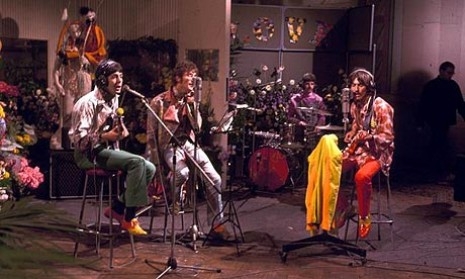
It’s probably the most famous pop album in the world, and here is its title track, “Sgt. Pepper’s Lonely Hearts Club Band” broken down into its constituent parts, and all in one clip.
With thanks to Tim Lucas
Bonus documentary The Making of Sgt Pepper, after the jump…
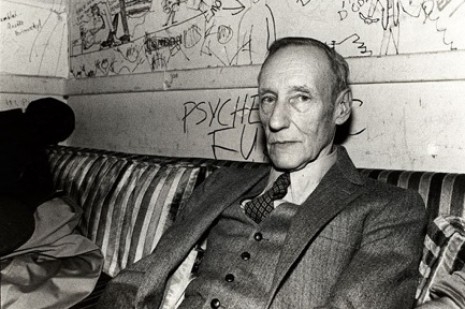
It caused nausea and vomiting when first shown at the Cinephone, Oxford Street, in London. Some of the audience demanded their money back, others hurled abuse and shouted “That’s sick,” and ““Its disgusting.” This was the idea, as writer William Burroughs and producer, Antony Balch wanted to achieve a complete “disorientation of the senses.”
Balch had a hard-on for the weird, unusual and sometimes depraved. It was a predilection born from his love of horror films - one compounded when as a child he met his idol, Bela Lugosi, the olde Austro-Hungarian junkie, who was touring Britain with the stage show that had made him famous, Dracula. Film was a love affair that lasted all of Balch’s life.
He also had a knack of making friends with the right people at the right time. In Paris he met and hung out with the artist Brion Gysin and druggie, Glaswegian Beat writer, Alexander Trocchi, who was then writing porn and editing a literary mag called Merlin, along with the likes of Christopher Logue. Through them, Balch met the two men who changed his life, Burroughs and Kenneth Anger.
Anger helped Balch with his ambitions as a cinema distributor, getting him a copy of Todd Browning’s classic Freaks, which was banned the UK, at that time. Balch paid Anger back when he later released his apocalyptic Invocation of My Demon Brother as a support feature.
Burroughs offered Balch something different - the opportunity to collaborate and make their own films. This they did, first with Towers Open Fire, an accessible montage of Burroughs’ routines, recorded on a Grundig tape recorder, cut-up to Balch’s filmed and found images of a “crumbling society.” Put together stuff like this and the chattering classes will always take you seriously. But don’t doubt it, for it was good.
But it was their second collaboration, Cut Ups which for me is far more interesting and proved far more controversial. Cut Ups was originally intended as a documentary called Guerilla Conditions, and was filmed between 1961 and 1965 in Tangiers and Paris. It included some footage from Balch’s aborted attempt to film the unfilmable Naked Lunch. The finished material was collated and then conventionally edited - but the process didn’t stop there, no. For Balch divided the finshed film into four sections of equal length, and then...
Bonus clip of ‘Bill and Tony’ after the jump…
Previously on Dangerous Minds

David Bowie was on a roll when he recorded “Suffragette City”, he was writing enough songs for his own catalog and for others to record. He’d already given Peter Noone of Herman’s Hermits “Oh! You Pretty Things”, which was quite a move for the toothsome pop star but, as rock writer Charles Shaar Murray noted, Noone’s version was “one of Rock and Roll’s most outstanding examples of a singer failing to achieve any degree of empathy whatsoever with the mood and content of a lyric.” Noone was possibly thinking about dental hygiene and girls rather than Aleister Crowley and philosopher Friedrich Nietzsche, whose ideas are referenced in the song. Bowie had also tried his hand at punting a teenage dress-designer into pop stardom with “Moonage Daydream” and then offered his services to Mott the Hoople.
Hoople were a superb band who hadn’t broken through to the level of success they deserved. Bowie was a fan and on hearing Mott were about to split, offered their lead singer, Ian Hunter, the song “Suffragette City” to record, if the band would stay together. Hunter felt it wouldn’t be a hit, and knew that after a few chart failures he had to have a winner. He therefore asked Bowie for “All the Young Dudes” which Hunter saw as a definite hit, it was and became an anthem for a generation of British youth. “All the Young Dudes” had originally been a part of Bowie’s plan for a concept album that told the story of an alien saving the Earth from destruction, which would become Ziggy Stardust.
“Suffragette City” was written in 1971 and recorded in January 1972. It gives a big nod towards The Small Faces “Wham Bam Thank You Ma’m”, and references (via the word “droogie”) Anthony Burgess’ A Clockwork Orange, which was the hit film of that year.
Infamously, when Bowie performed “Suffragette City” at the Oxford Town Hall in June 1972, he was photographed by Mick Rock apparently simulating oral sex on Mick Ronson’s guitar. Bowie was actually playing the guitar with his teeth. However, Rock’s photo was so iconic that Bowie convinced his manager, Tony Defries, into buying a whole page of advertising space in the UK music weekly, Melody Maker.
The line-up for the recording of “Suffragette City” was David Bowie: Vocals, Guitar; Mick Ronson: Guitar, piano and ARP synthesizer (which doubles as the saxophone); Trevor Bolder: Bass; Mick Woodmansey: Drums.
David Bowie - Vocals
Mick Ronson - Guitar
David Bowie and Mick Ronson - Acoustic Guitar, Piano and FX
Trevor Bolder Bass
Bonus Clip Small Faces “Wham Bam Thank You Mam”
Bonus Clip David Bowie - “Suffragette City” 1972
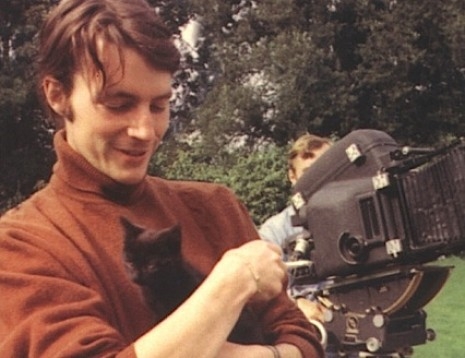
Michael Reeves was just twenty-four when he wrote and directed Witchfinder General. It would prove to be his most critically acclaimed and successful film, and would also be his last. For Reeves died not long after the film’s release from an accidental overdose - a tragic demise for a director of such immense talent, who had proven himself with three distinct horror films: Revenge of the Blood Beast, The Sorcerers and Witchfinder General (aka The Conqueror Worm).
Reeves’ precocious talent and early death led to a mythologizing of his life. The film writer David Pirie likened him to the Romantic poets Shelley, Byron and Keats, and as his death came at the end of the sixties, there was the inevitable twinning with the untimely deaths of troubled rock musicians, such as Jimi Hendrix and The Rolling Stones’ Brian Jones. Add to this the belief that Reeves may have killed himself, then we have the beginning of a cinematic legend - which is all good copy, but sadly removes the man from his art.
Reeves was precocious, he made his first film at the age of 8. Whether the resulting home-movie was good or bad is irrelevant, for what is important here is the realization of Reeves’ youthful ambition. At school he met and became friends with Ian Ogilvy, who went on to become an actor and star of all his films. From school, Reeves traveled to Hollywood at 16, where he door-stepped Don Siegel, director of Invasion of the Body Snatchers. Siegel was Reeves’ favorite director, and let’s be frank, it takes balls to turn up at someone’s door and convince them, then and there, that they need to employ you. Siegel was convinced and gave Reeves a job as his assistant - now, there’s a lesson here we all can learn from. Working for Siegel gave Reeves the opportunity to make the contacts and raise the cash for his own first feature film, Revenge of the Blood Beast, which starred Ogilvy and horror queen Barbara Steele. The film was well regarded and if not exactly brilliant, it marked the arrival of a new and original cinematic vision, and as with all young film-makers, there was soon the predictable murmur of Reeves being the next Orson Welles. Nice thought, but not exactly correct.
Two years later, in 1967, Reeves made his first important horror film, The Sorcerers, a trippy slasher which starred Ogilvy and film legend, Boris Karloff, who was at a stage of making many strange and often dreadful films, but had this time, as he did later with Peter Bogdanovich’s Targets, made a wise choice by agreeing to star in Reeves’ film. While Post-Modernism has made it easy to intellectualize anything, it is fair to say that in this case there is enough meat on this film’s bones to justify a more rigorous examination. The Sorcerers is more than a horror film, it has a subtext about voyeurism and cinema, and questions the cultural obsession with youth. The movie, and especially Karloff’s association with it, propelled Reeves into the top rank of British film directors, which saw him listed as the-man-most-likely-to, alongside the older and more experienced film-makers Ken Russell, Lindsay Anderson and Ken Loach. Don’t forget, at this point, Reeves was just 23.
But it is Witchfinder General that is Reeves most important and best film, a grisly horror that starred Vincent Price, Ian Ogilvy, Rupert Davies, Hilary Dwyer and Patrick Wymark.
The film had depth as it was based on the true story of Matthew Hopkins, the self-appointed Witchfinder General, who carried out the torture and execution of alleged sorcerers/witches during the English Civil War, in the 1640s. Hopkins was a notorious figure who made a fortune out of his activities, being paid roughly two bucks for every soul he saved by hanging, burning or drowning.
Vincent Price was brilliant as Matthew Hopkins, for Reeves had coaxed a more measured performance from the usually “camp and hammy” film star. The story goes Price was so annoyed by Reeves continual directions to underplay that one day he turned on Reeves and said, “I have made 84 movies, how many have you made?” To which Reeves replied, “Two good ones.” Price laughed, and thereafter, did as he was told. Of course, this may be apocryphal for, as years later, Price talked about his unhappiness in working with Reeves:
Well he hated me. He didn’t want me at all for the part. He wanted some other actor, and he got me and that was it. I didn’t like him, either, and it was one of the first times in my life that I’ve been in a picture where really the director and I just clashed [twists his hands], like that. He didn’t know how to talk to actors, he hadn’t had the experience, or talked to enough of them, so all the actors on the picture had a very bad time. I knew though, that in a funny, uneducated sort of way, he was right in his desire for me to approach the part in a certain way. He wanted it very serious and straight, and he was right, but he just didn’t know how to communicate with actors.
Hindsight is a great thing, and Price has the upperhand here, able to score points after the director’s dead and the film has been highly praised. Whatever the disagreements between the two on set, Reeves got Price to deliver one of his best cinematic performances.
The film’s release captured the public’s imagination, as many saw Witchfinder General‘s barbarism as a damning comment on the Vietnam War. Despite criticisms of the film’s shocking, documentary-like violence, Witchfinder proved to be Reeves biggest commercial success.
Yet after it, Reeves seemed to lose his way. He became unraveled, started to drink heavily, medicated himself with uppers and downers, and started a slow spiral into depression. Those who were witness to this give different accounts: some, the strain of working with Vincent Price; others, a failed romance; others still, Reeves’ nihilism. When visiting the composer Paul Ferris in hospital, where Ferris was recuperating from his own failed suicide attempt, Reeves joked, which between the two would be first to succeed in killing himself?
In February 1969, Reeves returned home after a night’s drinking, and swallowed a handful of anti-depressants. Whether intentionally or not is open to conjecture, but what’s known is Reeves died in the early hours of the 11th February from an overdose of barbiturates - his death robbed British film, and the horror world, of one of its most brilliant and original talents.
Parts 2 & 3 on Michael Reeves plus bonus trailer after the jump…

Who knows what Robert Downey jr. gets up to in his private life. Seriously, it’s none of our bees’ wax..but hell it won’t stop some people from fantasizing what he might get up to…
And these photoshopped images of the well-loved actor are certainly fantasies...
Created by Lisa René, who’s a college freshman, into “Graphic design. Science. Music. The 1940s. Vintage advertisements. Nerdfighters. LGBTQA. Nutella. Pita chips. The sound of heels clicking on a tile floor.”
The pix came from the site Pin-up RDJ which has sadly disappeared since this post first appeared….I wonder why?Anyhoo… Lisa also has the blog Who M.D. and co-runs Fuck Yeah Hotties in Glasses, which is, well, fuck, yeah, hotties in glasses. Of Pin-Up RDJ Lisa writes:
Vintage pinups are the pinnacle of art. Robert Downey jnr. is the pinnacle of sexy. It’s not rocket science.
No, not rocket science but rather jolly fun.
 With thanks to Steve Duffy
More of Lisa’s hot pictures of RJD after the jump…
With thanks to Steve Duffy
More of Lisa’s hot pictures of RJD after the jump…
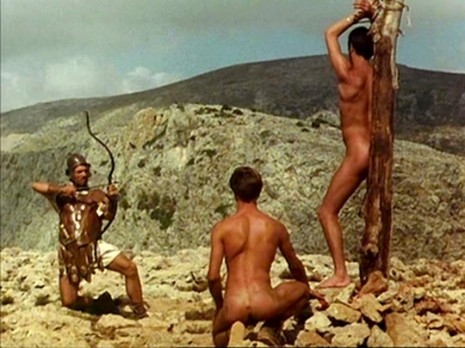
Here is a moment of pop culture history from Derek Jarman’s 1976, Latin romp Sebastiane. Blink and you will miss Patricia Quinn, Nell Campbell and Peter Hinwood from The Rocky Horror Picture Show, Punk icon Jordan (in stockings and suspenders) as Mammea Morgana, sprawled between Hinwood and the multi-talented artist Duggie Fields. Also, hovering around in this scene are sculptor, Andrew Logan, dancer and actor, Lindsay Kemp (who taught David Bowie mime), and designer, Christopher Hobbs.
Sebastiane was Jarman’s first film, co-directed with Paul Humfress, and caused considerable outrage with its exquisite scenes of gay love-making, images of an erect penis, and the fact the film’s dialogue was entirely in schoolboy Latin, where the word “Oedipus” was translated as “Motherfucker.” The music for the film was composed by Brian Eno.

Thanks to Soft Skull Press for sending me an advance paperback copy of Daniel Radosh’s “Rapture Ready: Adventures in the Parallel Universe of Christian Pop Culture.” This book is righteously demented—true to the title, it’s a voyage through the bizarre world of Christian pop culture, in a time where it is essentially one more underground scene, a pocket pop universe just like juggalos or furries (though slightly bigger—as Radosh points out, this stuff totals up to a $7 billion a year industry). Radosh takes us on a voyage through the cult of Left Behind, Christian rock, and the rest of the American Christian scene. Along the way we get some serious gems like “BibleZine” (!!!), bumper stickers reading “Any Sex that can Put You in Hell ISN’T SAFE” and Jay Bakker (Jim and Tammy’s son), who runs his own punk rock church.
I mean, reading this, it’s like… this is the alternate universe version of Dangerous Minds’ readers, like we went into a wormhole and came out with goatees and freshly baptized.
There are some absolutely jaw-droppingly great snippets of “Christian” lore from the book. For instance, Radosh includes a depiction of the Rapture from one of the “Left Behind” books:
“[M]en and women soldiers and horses seemed to explode where they stood. It was as if the very words of the Lord had superheated their blood, causing it to burst through their veins and skin… Their innards and entrails gushed to the desert floor, and as those around them turned to run, they too were slain, their blood pooling and rising in the unforgiving brightness of the glory of Christ.
Gloria in excelsis Deo, motherfucker.
Awesome. Or try this one, from a Christian joke book Radosh finds:
One women’s libber started out a speech: “Where would you men be without us women?” A guy in the back shouted, “In the Garden of Eden!”
I gotta remember that one to impress the ladies with.
Anyway, excellent, hilarious, disturbing, sobering book. I imagine it would make a great read alongside Jeff Sharlet’s “The Family: The Secret Fundamentalism at the Heart of American Power” for a look at where the Christian right is, both in politics and in culture at large, at this moment. (Interview with author below!)
(Rapture Ready!: Adventures in the Parallel Universe of Christian Pop Culture)